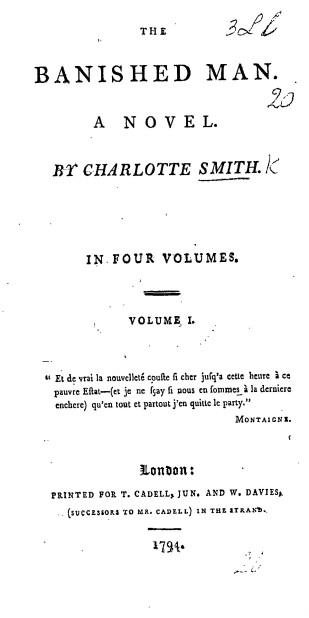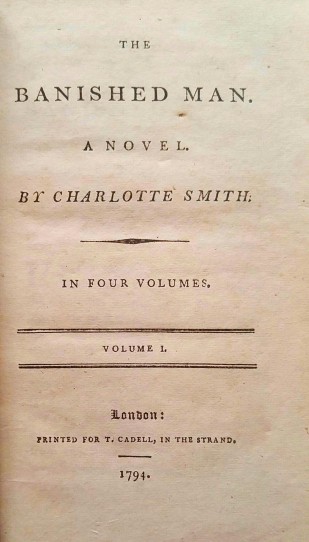As mentioned in a previous post, I am privileged to be spending three weeks as a Visiting Fellow at Chawton House Library. While I am here, my aim is to study the use of paratext (footnotes, epigraphs, prefaces, notes, and any other bits of ‘outside information’) in Smith’s novels. This fixation on text outside of the narrative led to the post below on the publication of The Banished Man.


In August 1794, Smith wrote to Thomas Cadell Jr complaining of errors in the copies she had received of her new novel, The Banished Man, noting that one copy had even been ‘bound wrongly.’¹ According to her letters, she had never had any issues of this kind before and it could have led to the atypical copy I found at Chawton House (pictured above). I found myself wondering why the errors and misbindings had occurred in the first place, so I looked into the history of the publishers, knowing that they had changed hands during the time Smith was writing and publishing. I wondered if, perhaps, the change from ‘T. Cadell’ to ‘T. Cadell Jun. and W. Davies’ had had an impact on the publishing process.
My hunch was correct. In the summer of 1793, Thomas Cadell Sr retired, leaving the company to his son (Cadell Jr) and his manager (William Davies). According to Richard Sher, by the mid-1790s, around the time that Cadell and Davies became the new proprietors, the publishing firm had slipped down the ranks to become the second in London, overtaken by George Robinson. The business continued to deteriorate throughout the decade, and by 1802 (when Cadell Sr died) it was noted that it had ‘fallen into a state of comparative decreptitude.’ While Sher argues that this statement was, perhaps, overblown, a decade later the firm was nearly bankrupted by Davies’ liberal spending, and was bailed out by Andrew Strahan (Cadell Sr’s old partner) for £20,000.²
After the difficulties in the publication of The Banished Man, Smith looked elsewhere when she published her next two novels. By December 1794, she was already writing to Cadell and Davies about sending her next novel, Montalbert, to a new publisher (Sampson Low) in a pointed letter about the errors she had corrected in the first print run of The Banished Man.³ It was the last novel Smith published with Cadell and Davies until four years later in 1798 when she came to publish her final novel, The Young Philosopher.
¹ The Collected Letters of Charlotte Smith Judith Stanton ed. (2003)
² Richard B. Sher The Enlightenment and the Book (2006)
³ The Collected Letters of Charlotte Smith Judith Stanton ed. (2003)
